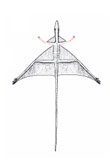
The triangular delta-wing shape found on many modern fighter jets was used by a small reptile to glide between trees 225 million years ago, a new study suggests.
Sharovipteryx mirabilis is known from only a single fossil. It was about 8 inches long, weighed less than a tenth of a pound and lived during the late Triassic, a time when the first dinosaurs were still evolving. Scientists knew that S. mirabilis had a membrane stretched across its hind legs, which allowed it to glide, but the exact shape of this membrane and the way it was attached to the animal's body has been debated.
In a new study, Gareth Dyke, a paleontologist at the University College Dublin in Ireland, and colleagues used wind-tunnel data from modern flying lizards and computer modeling to propose a new membrane configuration for S. mirabilis, one they say is unique because it is grounded in aerodynamics.
Alternative reconstructions of the wing membrane of Sharovipteryx mirabilis. The last one, D, is the delta-wing shape envisioned by Dyke and his team. Credit: G.J. Dyke et al. Click to Enlarge
The creature was previously the only known flying vertebrate to have a flight system dominated by its hind limbs, but the new study suggests it was also the world's first and only known delta-wing glider.
The finding, which will be detailed in an upcoming issue of the Journal of Evolutionary Biology, could also have implications for how flight evolved in a more well-known family of ancient flying reptiles: the pterosaurs.
Delta-wing shape
The new reconstruction suggests that the flight membrane of S. mirabilis was in the shape of a "delta-wing," the triangular shape used by modern fighter jets to fly at several times the speed of sound.
Sign up for the Live Science daily newsletter now
Get the world’s most fascinating discoveries delivered straight to your inbox.
"At low flight speeds, there is no real reason to have a wing this shape, but delta wings work efficiently at fast speeds, especially supersonic," Dyke told LiveScience.
The new reconstruction suggests S. mirabilis had not one, but two delta wings. The creature's forelimbs likely supported a triangular membrane as well. Splayed out, the creature would have looked roughly like a drawing of a two-tiered Christmas tree, with a small triangular membrane on top attached to its forelimbs, and a larger one stretched out across its hind limbs.
Without the forelimb membrane, S. mirabilis would not have been able to control its "pitch" during flight, the researchers say. Pitch is the up and down orientation of an aircraft during flight: A plane pitches up to climb and down to dive.
Strange sight
When airborne, S. mirabilis would have been a strange sight. It would have glided in an almost upright position, and its forelimbs would have been relatively free to grab small animals or things from trees. To control speed, the researchers think the reptilian glider varied the spread of its legs.
"Chances are, it would needed to have been gliding from higher pieces of land or from trees to get into a passive glide in the first place," Dyke said.
The new reconstruction could have implications for theories about how flight evolved in pterosaurs, another ancient flying reptile that some scientists have speculated S. mirabilis was an early ancestor of. Unlike S. mirabilis, however, the wing membranes of pterosaurs attached to their forelimbs and hind limbs.
"If [S. mirabilis] was an ancestral form for pterosaurs, then unlike birds and bats, which have a forelimb-dominated flight system, the pterosaur condition may have evolved from a hind-limb dominated flight system," Dyke said.
- The First Biplanes Were Dinosaurs
- Avian Ancestors: Dinosaurs That Learned to Fly
- Futuristic Spy Plane Maneuvers Like a Bird
- Secret of Bird Flight Revealed
- Gallery: Dinosaur Fossils
- Today’s Dinosaurs









